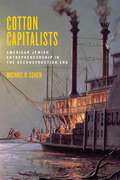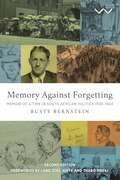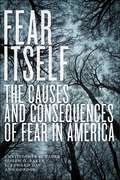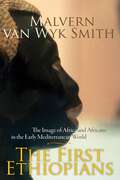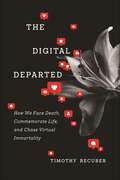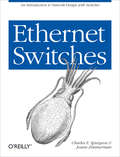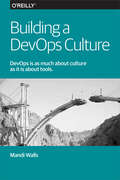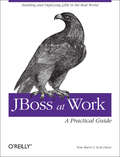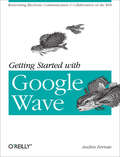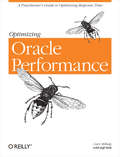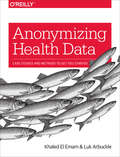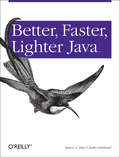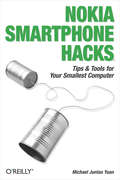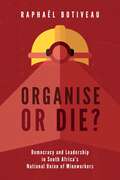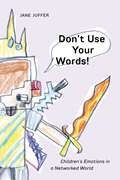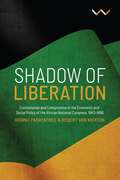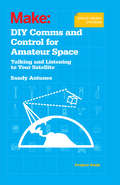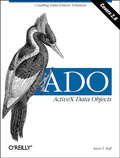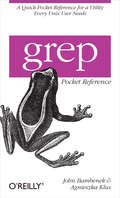- Table View
- List View
Cotton Capitalists: American Jewish Entrepreneurship in the Reconstruction Era (Goldstein-Goren Series in American Jewish History #8)
by Michael R. CohenHonorable Mention, 2019 Saul Viener Book Prize, given by the American Jewish Historical SocietyA vivid history of the American Jewish merchants who concentrated in the nation’s most important economic sector In the nineteenth century, Jewish merchants created a thriving niche economy in the United States’ most important industry—cotton—positioning themselves at the forefront of expansion during the Reconstruction Era. Jewish success in the cotton industry was transformative for both Jewish communities and their development, and for the broader economic restructuring of the South. Cotton Capitalists analyzes this niche economy and reveals its origins. Michael R. Cohen argues that Jewish merchants’ status as a minority fueled their success by fostering ethnic networks of trust. Trust in the nineteenth century was the cornerstone of economic transactions, and this trust was largely fostered by ethnicity. Much as money flowed along ethnic lines between Anglo-American banks, Jewish merchants in the Gulf South used their own ethnic ties with other Jewish-owned firms in New York, as well as Jewish investors across the globe, to capitalize their businesses. They relied on these family connections to direct Northern credit and goods to the war-torn South, avoiding the constraints of the anti-Jewish prejudices which had previously denied them access to credit, allowing them to survive economic downturns. These American Jewish merchants reveal that ethnicity matters in the development of global capitalism. Ethnic minorities are and have frequently been at the forefront of entrepreneurship, finding innovative ways to expand narrow sectors of the economy. While this was certainly the case for Jews, it has also been true for other immigrant groups more broadly. The story of Jews in the American cotton trade is far more than the story of American Jewish success and integration—it is the story of the role of ethnicity in the development of global capitalism.
Memory Against Forgetting: Memoir of a Time in South African Politics 1938 - 1964
by Rusty BernsteinLionel ‘Rusty’ Bernstein was arrested at Liliesleaf Farm, Rivonia, on 11 July 1963 and tried for sabotage, alongside Nelson Mandela, Walter Sisulu, Govan Mbeki and other leaders of the African National Congress and Umkhonto we Sizwe in what came to be known as the Rivonia Trial. He was acquitted in June 1964, but was immediately rearrested. After being released on bail, he fled with his wife Hilda into exile, followed soon afterwards by their family. This classic text, first published in 1999, is a remarkable man’s personal memoir of a life in South African resistance politics from the late 1930s to the 1960s. In recalling the events in which he participated, and the way in which the apartheid regime affected the lives of those involved in the opposition movements, Rusty Bernstein provides valuable insights into the social and political history of the era.
Kielezo cha Insha
by Shabaan RobertKielezo cha Insha is the earliest guide to essay writing in Kiswahili, published by Wits University Press in 1954. After Tanzania's independence in 1961 the book was not available for several decades because of the political and economic sanctions against the apartheid regime in South Africa.The book covers pertinent issues in composition writing, including the purpose and types of composition, preparation, structure, language and style, cohesion, objectivity and punctuation. It includes 60 model essays together with Robert's thoughts and perspectives on the issues he addresses. The topics include some of the issues current at the time, such as ;secret marriages, culture, the environment, language and nationhood, patriotism, womens oppression, health, and the meaning of life and death.After being out of print for more than sixty years, Wits University Press has reissued the text as a testament to its enduring historical value. Kielezo cha Insha is an example of Robert's educational and pedagogical writing at its best.
Fear Itself: The Causes and Consequences of Fear in America
by Joseph O. Baker Christopher D. Bader L. Edward Day Ann GordonAn antidote to the culture of fear that dominates modern lifeFrom moral panics about immigration and gun control to anxiety about terrorism and natural disasters, Americans live in a culture of fear. While fear is typically discussed in emotional or poetic terms—as the opposite of courage, or as an obstacle to be overcome—it nevertheless has very real consequences in everyday life. Persistent fear negatively effects individuals’ decision-making abilities and causes anxiety, depression, and poor physical health. Further, fear harms communities and society by corroding social trust and civic engagement. Yet politicians often effectively leverage fears to garner votes and companies routinely market unnecessary products that promise protection from imagined or exaggerated harms.Drawing on five years of data from the Chapman Survey of American Fears—which canvasses a random, national sample of adults about a broad range of fears—Fear Itself offers new insights into what people are afraid of and how fear affects their lives. The authors also draw on participant observation with Doomsday preppers and conspiracy theorists to provide fascinating narratives about subcultures of fear.Fear Itself is a novel, wide-ranging study of the social consequences of fear, ultimately suggesting that there is good reason to be afraid of fear itself.
The First Ethiopians: The image of Africa and Africans in the early Mediterranean world
by Malvern van SmithThe First Ethiopians explores the images of Africa and Africans that evolved in ancient Egypt, in classical Greece and imperial Rome, in the early Mediterranean world, and in the early domains of Christianity. Inspired by curiosity regarding the origins of racism in southern Africa, Malvern van Wyk Smith consulted a wide range of sources: from rock art to classical travel writing; from the pre-Dynastic African beginnings of Egyptian and Nubian civilisations to Greek and Roman perceptions of Africa; from Khoisan cultural expressions to early Christian conceptions of Africa and its people as ‘demonic’; from Aristotelian climatology to medieval cartography; and from the geo-linguistic history of Africa to the most recent revelations regarding the genome profile of the continent’s peoples. His research led to a startling proposition: Western racism has its roots in Africa itself, notably in late New Kingdom Egypt, as its ruling elites sought to distance Egyptian civilisation from its African origins. Kushite Nubians, founders of Napata and Meroë who, in the eighth century BCE, furnished the black rulers of the twenty-fifth Dynasty in Egypt, adopted and adapted such Dynastic discriminations in order to differentiate their own ‘superior’ Meroitic civilisation from the world of ‘other Ethiopians’. In due course, archaic Greeks, who began to arrive in the Nile Delta in the seventh century BCE, internalised these distinctions in terms of Homer’s identification of ‘two Ethiopias’, an eastern and a western, to create a racialised (and racist) discourse of ‘worthy’ and ‘savage Ethiopians’. Such conceptions would inspire virtually all subsequent Roman and early medieval thinking about Africa and Africans, and become foundational in European thought. The book concludes with a survey of the special place that Aksumite Ethiopia – later Abyssinia – has held in both European and African conceptual worlds as the site of ‘worthy Ethiopia’, as well as in the wider context of discourses of ethnicity and race.
The Digital Departed: How We Face Death, Commemorate Life, and Chase Virtual Immortality
by Timothy RecuberA fascinating exploration of the social meaning of digital deathFrom blogs written by terminally ill authors to online notes left by those considering suicide, technology has become a medium for the dead and the dying to cope with the anxiety of death. Services like artificial intelligence chatbots, mind-uploading, and postmortem blog posts offer individuals the ability to cultivate their legacies in a bid for digital immortality. The Digital Departed explores the posthumous internet world from the perspective of both the living and the dead.Timothy Recuber traces how communication beyond death evolved over time. Historically, the methods of mourning have been characterized by unequal access to power and privilege. However, the internet offers more agency to the dead, allowing users accessibility and creativity in curating how they want to be remembered.Based on hundreds of blog posts, suicide notes, Twitter hashtags, and videos, Recuber examines the ways we die online, and the digital texts we leave behind. Combining these data with interviews, surveys, analysis of news coverage, and a historical overview of the relationship between death and communication technology going back to pre-history, The Digital Departed explains what it means to live and die on the internet today. In this thought-provoking and uniquely troubling work, Recuber shows that although we might pass away, our digital souls live on, online, in a kind of purgatory of their own.
Ethernet Switches: An Introduction to Network Design with Switches
by Joann Zimmerman Charles E. SpurgeonIf you’re ready to build a large network system, this handy excerpt from Ethernet: The Definitive Guide, Second Edition gets you up to speed on a basic building block: Ethernet switches. Whether you’re working on an enterprise or campus network, data center, or Internet service provider network, you’ll learn how Ethernet switches function and how they’re used in network designs.This brief tutorial also provides an overview of the most important features found in switches, from the basics to more advanced features found in higher-cost and specialized switches.Get an overview of basic switch operation, the spanning tree protocol, and switch performance issuesLearn about switch management and some of the most widely used switch featuresDiscover how a hierarchical design can help maintain stable network operationsDelve into special-purpose switches, such as multi-layer, access, stacking, and wireless access-point switchesLearn about advanced switch features designed for specific networking environmentsDive deeper into switches, with a list of protocol and package documentation
Building a DevOps Culture
by Mandi WallsDevOps is as much about culture as it is about toolsWhen people talk about DevOps, they often emphasize configuration management systems, source code repositories, and other tools. But, as Mandi Walls explains in this Velocity report, DevOps is really about changing company culture—replacing traditional development and operations silos with collaborative teams of people from both camps.The DevOps movement has produced some efficient teams turning out better products faster. The tough part is initiating the change. This report outlines strategies for managers looking to go beyond tools to build a DevOps culture among their technical staff.Topics include:Documenting reasons for changing to DevOps before you commitDefining meaningful and achievable goalsFinding a technical leader to be an evangelist, tools and process expert, and shepherdStarting with a non-critical but substantial pilot projectFacilitating open communication among developers, QA engineers, marketers, and other professionalsRealigning your team’s responsibilities and incentivesLearning when to mediate disagreements and conflictsDownload this free report and learn how to the DevOps approach can help you create a supportive team environment built on communication, respect, and trust.Mandi Walls is a Senior Consultant with Opscode.
JBoss at Work: A Practical Guide
by Scott Davis Tom MarrsConsisting of a number of well-known open source products, JBoss is more a family of interrelated services than a single monolithic application. But, as with any tool that's as feature-rich as JBoss, there are number of pitfalls and complexities, too.Most developers struggle with the same issues when deploying J2EE applications on JBoss: they have trouble getting the many J2EE and JBoss deployment descriptors to work together; they have difficulty finding out how to get started; their projects don't have a packaging and deployment strategy that grows with the application; or, they find the Class Loaders confusing and don't know how to use them, which can cause problems.JBoss at Work: A Practical Guide helps developers overcome these challenges. As you work through the book, you'll build a project using extensive code examples. You'll delve into all the major facets of J2EE application deployment on JBoss, including JSPs, Servlets, EJBs, JMS, JNDI, web services, JavaMail, JDBC, and Hibernate. With the help of this book, you'll:Implement a full J2EE application and deploy it on JBossDiscover how to use the latest features of JBoss 4 and J2EE 1.4, including J2EE-compliant web servicesMaster J2EE application deployment on JBoss with EARs, WARs, and EJB JARsUnderstand the core J2EE deployment descriptors and how they integrate with JBoss-specific descriptorsBase your security strategy on JAASWritten for Java developers who want to use JBoss on their projects, the book covers the gamut of deploying J2EE technologies on JBoss, providing a brief survey of each subject aimed at the working professional with limited time.If you're one of the legions of developers who have decided to give JBoss a try, then JBoss at Work: A Practical Guide is your next logical purchase. It'll show you in plain language how to use the fastest growing open source tool in the industry today. If you've worked with JBoss before, this book will get you up to speed on JBoss 4, JBoss WS (web services), and Hibernate 3.
Getting Started with Google Wave
by Andres FerrateGet in front of Google Wave, the exciting new real-time communication and collaboration technology that unifies email, instant messaging (IM), wiki, and social networking functions on one integrated platform. Getting Started with Google Wave gives you a good look at this game-changing technology while it's still in the development stage. In the first two chapters, you'll quickly learn about the Google Wave structure and how it works. The second two chapters help you work with the Google Wave Client, a web app that allows end users to participate and collaborate.Become familiar with Google Wave's key concepts and terminologyLearn about the threaded conversation model incorporated into conversations, or wavesGet use cases that show how the platform offers consumers a distinct advantage over current communication and collaboration technologiesLearn about extensions such as wavelets, blips, gadgets, and robotsMore than a million users have downloaded Google Wave since it became available in public preview. Don't wait. Catch the wave with this book.
Oracle SQL*Plus Pocket Reference: A Guide to SQL*Plus Syntax (Pocket Reference (O'Reilly))
by Jonathan GennickThe Oracle SQLPlus Pocket Reference is a must-have for anyone working with Oracle databases, especially those looking to maximize the effectiveness of SQLPlus. As Oracle's long-standing interactive query tool, SQLPlus is available at every Oracle site, from the largest data warehouse to the smallest single-user system. Despite its wide use, however, SQLPlus is still often not completely understood or fully utilized.Database administrators and developers alike will therefore find the Oracle SQLPlus Pocket Reference to be extremely beneficial. In addition to summarizing all of the SQLPlus syntax and format options, including new Oracle Database 10g features, this handy, on-the-job guide specifically shows readers how to:Differentiate between SQL and SQLPlusInteract with SQLPlus from both the command line and the web browserSelect, insert, update, and delete dataFormat both text and HTML reports with SQLPlusSpecify SQLPlus commands and format elementsTune SQL queriesThe new third edition of this book has been updated for Oracle Database 10g to include information on both SQLPlus and SQL. New SQL information includes the SELECT statement's new MODEL clause, flashback queries, partition outer joins, and DBMS_XPLAN.With its quick-reference format and compact size, the Oracle SQLPlus Pocket Reference follows in the long line of successful "pocket references" offered by O'Reilly. It also serves as the ideal companion to O'Reilly's larger, more comprehensive book on SQLPlus, the bestselling Oracle SQLPlus: The Definitive Guide.Author Jonathan Gennick is an editor for O'Reilly specializing in database and programming titles, having amassed some 17 years of programming and database management experience.
Optimizing Oracle Performance: A Practitioner's Guide to Optimizing Response Time
by Cary Millsap Jeff HoltOracle system performance inefficiencies often go undetected for months or even years--even under intense scrutiny--because traditional Oracle performance analysis methods and tools are fundamentally flawed. They're unreliable and inefficient.Oracle DBAs and developers are all too familiar with the outlay of time and resources, blown budgets, missed deadlines, and marginally effective performance fiddling that is commonplace with traditional methods of Oracle performance tuning. In this crucial book, Cary Millsap, former VP of Oracle's System Performance Group, clearly and concisely explains how to use Oracle's response time statistics to diagnose and repair performance problems. Cary also shows how "queueing theory" can be applied to response time statistics to predict the impact of upgrades and other system changes.Optimizing Oracle Performance eliminates the time-consuming, trial-and-error guesswork inherent in most conventional approaches to tuning. You can determine exactly where a system's performance problem is, and with equal importance, where it is not, in just a few minutes--even if the problem is several years old.Optimizing Oracle Performance cuts a path through the complexity of current tuning methods, and streamlines an approach that focuses on optimization techniques that any DBA can use quickly and successfully to make noticeable--even dramatic--improvements.For example, the one thing database users care most about is response time. Naturally, DBAs focus much of their time and effort towards improving response time. But it is entirely too easy to spend hundreds of hours to improve important system metrics such as hit ratios, average latencies, and wait times, only to find users are unable to perceive the difference. And an expensive hardware upgrade may not help either.It doesn't have to be that way. Technological advances have added impact, efficiency, measurability, predictive capacity, reliability, speed, and practicality to the science of Oracle performance optimization. Optimizing Oracle Performance shows you how to slash the frustration and expense associated with unraveling the true root cause of any type of performance problem, and reliably predict future performance.The price of this essential book will be paid back in hours saved the first time its methods are used.
Excel 2007: The Missing Manual
by Matthew MacDonaldMicrosoft Excel continues to grow in power, sophistication, and capability, but one thing that has changed very little since the early '90s is its user interface. The once-simple toolbar has been packed with so many features over the years that few users know where to find them all. Microsoft has addressed this problem in Excel 2007 by radically redesigning the user interface with a tabbed toolbar that makes every feature easy to locate and use. Unfortunately, Microsoft's documentation is as scant as ever, so even if users can find advanced features, they probably won't know what to do with them.Excel 2007: The Missing Manual covers the entire gamut of how to build spreadsheets, add and format information, print reports, create charts and graphics, and use basic formulas and functions. Like its siblings in the Missing Manual series, this book crackles with a fine sense of humor and refreshing objectivity about its subject, guiding readers through the new Excel with clear explanations, step-by-step instructions, lots of illustrations, and friendly, time-saving advice. It's a perfect primer for small businesses with no techie to turn to, as well as those who want to organize household and office information.
Anonymizing Health Data: Case Studies and Methods to Get You Started
by Luk Arbuckle Khaled El EmamUpdated as of August 2014, this practical book will demonstrate proven methods for anonymizing health data to help your organization share meaningful datasets, without exposing patient identity. Leading experts Khaled El Emam and Luk Arbuckle walk you through a risk-based methodology, using case studies from their efforts to de-identify hundreds of datasets.Clinical data is valuable for research and other types of analytics, but making it anonymous without compromising data quality is tricky. This book demonstrates techniques for handling different data types, based on the authors’ experiences with a maternal-child registry, inpatient discharge abstracts, health insurance claims, electronic medical record databases, and the World Trade Center disaster registry, among others.Understand different methods for working with cross-sectional and longitudinal datasetsAssess the risk of adversaries who attempt to re-identify patients in anonymized datasetsReduce the size and complexity of massive datasets without losing key information or jeopardizing privacyUse methods to anonymize unstructured free-form text dataMinimize the risks inherent in geospatial data, without omitting critical location-based health informationLook at ways to anonymize coding information in health dataLearn the challenge of anonymously linking related datasets
Better, Faster, Lighter Java
by Justin Gehtland Bruce TateSometimes the simplest answer is the best. Many Enterprise Java developers, accustomed to dealing with Java's spiraling complexity, have fallen into the habit of choosing overly complicated solutions to problems when simpler options are available. Building server applications with "heavyweight" Java-based architectures, such as WebLogic, JBoss, and WebSphere, can be costly and cumbersome. When you've reached the point where you spend more time writing code to support your chosen framework than to solve your actual problems, it's time to think in terms of simplicity.In Better, Faster, Lighter Java, authors Bruce Tate and Justin Gehtland argue that the old heavyweight architectures are unwieldy, complicated, and contribute to slow and buggy application code. As an alternative means for building better applications, the authors present two "lightweight" open source architectures: Hibernate--a persistence framework that does its job with a minimal API and gets out of the way, and Spring--a container that's not invasive, heavy or complicated.Hibernate and Spring are designed to be fairly simple to learn and use, and place reasonable demands on system resources. Better, Faster, Lighter Java shows you how they can help you create enterprise applications that are easier to maintain, write, and debug, and are ultimately much faster.Written for intermediate to advanced Java developers, Better, Faster, Lighter Java, offers fresh ideas--often unorthodox--to help you rethink the way you work, and techniques and principles you'll use to build simpler applications. You'll learn to spend more time on what's important. When you're finished with this book, you'll find that your Java is better, faster, and lighter than ever before.
Nokia Smartphone Hacks: Tips & Tools for Your Smallest Computer (Hacks)
by Michael Juntao YuanNokia's smartphones pack a powerful computer into a very small space. Unlike your desktop or laptop, your smallest computer can be connected to the Internet all the time, and can interact with the world around it through its camera, voice recognition, and its traditional phone keypad. Nokia smartphones combine these features with impressive storage options and a host of networking protocols that make this smallest computer the only thing a road warrior truly needs.If you're still cracking open your laptop or pining for your desktop while you're on the road, you haven't begun to unlock your Nokia's full potential. Nokia Smartphone Hacks is dedicated to tricking out your smartphone and finding all the capabilities lurking under the surface. Learn how to:Unlock your phone so that you can use it with any carrierAvoid and recover from malicious mobile softwareWatch DVD movies on the phoneUse the phone as a remote controlUse the phone as a data modem for your notebookCheck your email and browse the webPost to your weblog from your phoneRecord phone conversationsChoose mobile service plansTransfer files between the phone and your computerWhether you want to use your smartphone as your lifeline while you're on the road, or you're just looking for a way to make the most of the time you spend waiting in lines, you'll find all the user-friendly tips, tools, and tricks you need to become massively productive with your Nokia smartphone. With Nokia Smartphone Hacks, you'll unleash the full power of that computer that's sitting in your pocket, purse, or backpack.
Organise or Die?: Democracy and Leadership in South Africa’s National Union of Mineworkers
by Raphaël BotiveauThe story of one of the leading trade unions in South Africa, the National Union of Mineworkers, and its role in the struggle against white minority rule. Organise or Die? Democracy and Leadership in South Africa's National Union of Mineworkers (NUM) is the first in-depth study of one of the leading trade unions in the country. Founded in 1982, the trade union played a key role in the struggle against white minority rule, before turning into a central protagonist of the ruling Tripartite Alliance after apartheid. Deftly navigating through workerist, social movement and political terrains that shape the South African labour landscape, this book sheds light on the path that led to the unprecedented 2012 Marikana massacre, the dissolution of the Congress of South African Trade Unions (Cosatu) federation and to fractures within the African National Congress (ANC) itself. Working with the notions of organisational agency and strategic bureaucratisation, Raphaël Botiveau shows how the founding leadership of NUM built their union's structures with a view to mirror those of the multinational mining companies NUM faced. Good leadership proved key to the union's success in recruiting and uniting mineworkers and NUM became an impressive school for union and political cadres, producing a number of South Africa's top post-apartheid leaders. An incisive analysis of leadership styles and strategies shows how the fragile balance between an increasingly distant leadership and an increasingly militant membership gradually broke down. Botiveau provides a compelling narrative of NUM's powerful history and the legacy of its leadership. It will appeal to a broad readership - including journalists, students and social sciences scholars - interested in South Africa's contemporary politics and labour history.
Love, Death, Fame: Poetry and Lore from the Emirati Oral Tradition (Library of Arabic Literature #67)
by al-Māyidī ibn ẒāhirPoems and tales of a literary forefather of the United Arab EmiratesLove, Death, Fame features the poetry of al-Māyidī ibn Ẓāhir, who has been embraced as the earliest poet in what would later become the United Arab Emirates. Although little is known about his life, he is the subject of a sizeable body of folk legend and is thought to have lived in the seventeenth century, in the area now called the Emirates. The tales included in Love, Death, Fame portray him as a witty, resourceful, scruffy poet, at times combative and at times kindhearted.His poetry primarily features verses of wisdom and romance, with scenes of clouds and rain, desert migrations, seafaring, and pearl diving. Like Arabian Romantic and Arabian Satire, this collection is a prime example of Nabaṭī poetry, combining vernacular language of the Arabian Peninsula with archaic vocabulary and images dating to Arabic poetry’s very origins. Distinguished by Ibn Ẓāhir’s unique voice, Love, Death, Fame offers a glimpse of what life was like four centuries ago in the region that is now the UAE.A bilingual Arabic-English edition.
Don't Use Your Words!: Children's Emotions in a Networked World
by Jane JufferHow children are taught to control their feelings and how they resistthis emotional management through cultural production.Today, even young kids talk to each other across social media by referencing memes,songs, and movements, constructing a common vernacular that resists parental, educational, and media imperatives to name their feelings and thus control their bodies. Over the past two decades, children’s television programming has provided a therapeutic site for the processing of emotions such as anger, but in doing so has enforced normative structures of feeling that, Jane Juffer argues, weaken the intensity and range of children’s affective experiences.Don’t Use Your Words! seeks to challenge those norms, highlighting the ways that kids express their feelings through cultural productions including drawings, fan art, memes, YouTube videos, dance moves, and conversations while gaming online. Focusing on kids between ages five and nine, Don’t Use Your Words! situates these productions in specific contexts, including immigration policy referenced in drawings by Central American children just released from detention centers and electoral politics as contested in kids’ artwork expressing their anger at Trump’s victory. Taking issue with the mainstream tendency to speak on behalf of children, Juffer argues that kids have the agency to answer for themselves: what does it feel like to be a kid?
CATARACT
by Callum AngusCATARACT begins in the desert, climaxes in fleeing wildfires, and ends in an OSHA conference call. From winery workers dying in the fields to endangered desert tortoises unable to outrun the flames, CATARACT is a venting of ecological rage, a communal cry in many voices against the few who keep us in this situation by using power to perpetuate inaction.
Shadow of Liberation: Contestation and Compromise in the Economic and Social Policy of the African National Congress, 1943-1996
by Vishnu Padayachee Robert Van NiekerkShadow of Liberation explores the intricate twists, turns, contestations and compromises of ANC economic and social policymaking with a focus on the transition era of the 1990’s and the early years of democracyWith the damning revelations by the Zondo Commission of Inquiry into State Capture on the massive corruption of the South African body politic, the timing of this book could not be more relevant. South Africans need to confront the economic and social policy choices that the liberation movement made and to see how these decisions may have facilitated the conditions for corruption to emerge and flourish. Answers are needed. Padayachee and van Niekerk focus their attention on the primary question of how and why the ANC, given its historical anti-inequality, re-distributive stance, come in the 1990s, to such a dramatic turn around and move towards an essentially market-dominated approach. Were they pushed or did they go willingly? What role if any did Western governments and international financial institutions play? And what of the role of the late apartheid state and South African business? Did leaders and comrades ‘sell out’ the ANC’s emancipatory policy vision? Shadow of Liberation tries to provide answers to these questions drawing on the best available primary archival evidence as well as extensive interviews with key protagonists across the political, non-government and business spectrum. The authors argue that the ANC’s emancipatory policy agenda was broadly to establish a social democratic welfare state upholding rights of social citizenship. However its economic policy framework to realise this emancipatory mission was either non-existent or egregiously misguided.
One Virus, Two Countries: What COVID-19 Tells Us About South Africa
by Steven FriedmanHas South Africa ‘done well’ at limiting illness and deaths during the COVID-19 pandemic? Academic and political commentator, Steven Friedman, thinks not. While the country’s mainstream media believes it has, in his view the evidence tells another story. South Africa has experienced by far the most cases and deaths in Africa – at one point as many as the rest of the continent combined.One Virus, Two Countries: What Covid-19 tells us about South Africa offers a searing analysis of government and expert scientists’ responses to the pandemic. Friedman argues that South Africa is two societies in one – a ‘First World’ which resembles Western Europe and North America, and a ‘Third World’ which looks much like the rest of Africa or South Asia. The South African state, the media and the scientific community have largely tried to deal with the virus through a ‘First World’ lens in which much of the country was either invisible or a problem – not a partner. Friedman argues this approach prevented the country from responding in a way which would have protected most citizens. This is why case numbers and deaths are so high: South Africa has done worse than the rest of Africa not despite the fact that it has a ‘more developed’ health system, but because it does.One Virus, Two Countries is a controversial book that will rouse much needed debate about South Africa’s health and economic system in a context of serious inequality.
DIY Comms and Control for Amateur Space: Talking and Listening to Your Satellite
by Sandy AntunesRadio spectrum for commanding and recording from our satellites is a shared resource with subtle hurdles. We walk the path originally paved by AMSATs to discuss the steps and licensing needed to set up and operate both a command uplink and a data download station and network. Find out how playing nicely with others maximizes your ability to get your data down.
ADO: Creating Data-Driven Solutions
by Jason T RoffGetting data across platforms and formats is a cornerstone of present-day applications development. ADO: ActiveX Data Objects is both an introduction and a complete reference to ADO (ActiveX Data Objects), Microsoft's universal data access solution. You'll learn how to easily access data in multiple formats--such as email messages, Access databases, Word documents, and SQL databases--even on different platforms, without spending extra time learning every last detail about each format.Author Jason Roff shows by example how to use ADO with your programming language of choice to save programming time, so you can concentrate on the content and quality of your application rather than the nitty-gritty of specific data formats.ADO: ActiveX Data Objects includes:Chapters dedicated to the Connection, Recordset, Field, and Command objects and the Properties collectionA complete, detailed reference listing every ADO object, method, property, and event, in convenient alphabetical orderChapters on ADO architecture, data shaping, the ADO Event ModelAn appendix containing enumeration tables used by ADO objects and collections, listed alphabeticallyBrief introductions to RDS, ADO.NET, and SQLADO: ActiveX Data Objects is a versatile one-stop guide to both the theory and practice of programming with ADO through Version 2.6. The thorough reference section and topic-specific chapters will help you find quick answers about the details of objects, collections, methods, and properties of ADO. And the abundance of practical code examples will give you a good grasp of how to use ADO's strong points most effectively.
grep Pocket Reference: A Quick Pocket Reference for a Utility Every Unix User Needs (Pocket Reference (O'Reilly))
by Agnieszka Klus John Bambenekgrep Pocket Reference is the first guide devoted to grep, the powerful Unix content-location utility. This handy book is ideal for system administrators, security professionals, developers, and others who want to learn more about grep and take new approaches with it -- for everything from mail filtering and system log management to malware analysis. With grep Pocket Reference, you will:Learn methods for filtering large files for specific contentAcquire information not included in the current grep documentationGet several tricks for using variants such as egrepKeep key information about grep right at your fingertipsFind the answers you need about grep quickly and easily. If you're familiar with this utility, grep Pocket Reference will help you refresh your basic knowledge, understand rare situations, and work more efficiently. If you're new to grep, this book is the best way to get started.
